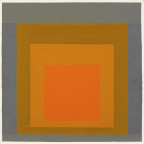Biography
Waddington Custot Galleries, in collaboration with The Josef and Anni Albers Foundation, are pleased to announce an exhibition of paintings by Josef Albers, dating from 1931 to 1958. The exhibition includes early monochrome paintings from his Biconjugates and Kineticsseries, as well as Variants, dating from the late 40s to 50s. Within these differing compositions, Albers experimented with form, line and colour to explore visual perception.
Steps (1931-1956), the earliest work in the exhibition, made after one of Albers's glass pieces, has two stair-like constructions in black, white and grey; a larger one in the right foreground and a smaller version in the upper left, which "float" on a black background. Following the "steps", up and down, in this ambiguous space, the folded forms appear to flip forwards and backwards, sometimes creating the illusion of motion. In Vice Versa (C) (1943), a biconjugate, Albers introduced a landscape format; geometric, interlocking, angular shapes appear to mirror each other on a horizontal plane.
Albers began his Variants series in 1947, the year he spent a sabbatical in Mexico. Also known as Adobes, theVariants derive their basic geometric composition, of multiple, interlocking and apparently overlapping rectangles, from the simple facades of the traditional Adobe houses, with their two windows set either side of the doorway. As well as monochrome paintings in this new format, in the Variant series, Albers used vibrant colour shapes which allowed him to closely examine colour relationships.







